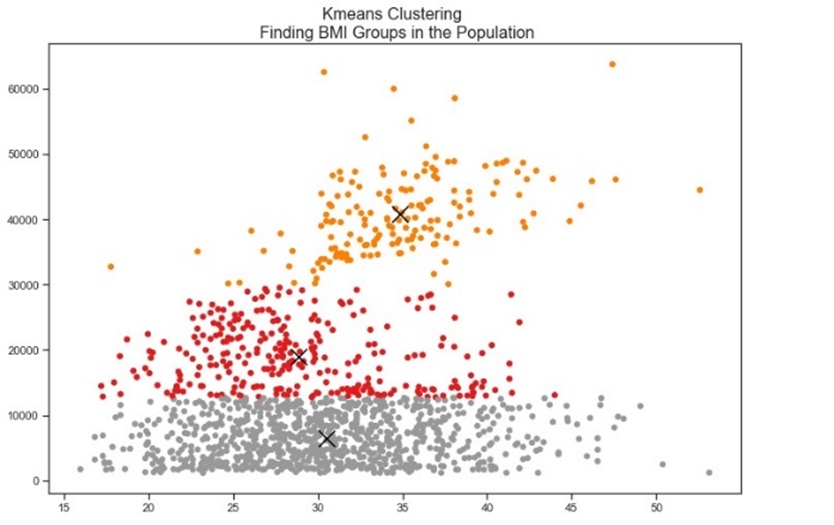The Financial Toll of BMI on Health Services: A Comparative Cost Assessment Using Big Data

DOI:
https://doi.org/10.54060/a2zjournals.jase.46Keywords:
Big Data, Machine Learning, Health Risk Assessment, cost-effectiveAbstract
The escalating prevalence of elevated Body Mass Index (BMI) levels worldwide has led to a substantial burden on healthcare systems, posing considerable economic challenges. This research paper presents a comparative cost assessment that delves into the intricate relationship between BMI and its financial impact on health ser-vices. The rise in obesity and overweight individuals has been linked to a surge in chronic health conditions, including cardiovascular diseases, type 2 diabetes, muscu-loskeletal disorders, and certain cancers, which necessitate extensive medical inter-ventions, long-term treatments, and management, thereby amplifying healthcare expenditures significantly. Beyond direct healthcare costs, the economic repercus-sions encompass productivity losses, absenteeism from work, and diminished quality of life for affected individuals. This comparative cost assessment aims to analyze healthcare expenditure data from various demographic groups to uncover the dif-ferential impact of BMI on healthcare costs. By exploring preventive measures, in-terventions, and policy frameworks, the study seeks to mitigate the economic strain on healthcare systems resulting from BMI-related health complications. Under-standing the intricate relationship between BMI and healthcare costs is crucial in formulating evidence-based strategies to address this growing challenge, providing valuable insights for policymakers, healthcare practitioners, and stakeholders, guid-ing the implementation of effective measures to alleviate the financial burden on health services while promoting improved health outcomes for populations globally.
Downloads
References
K. F. Adams et al., “Overweight, obesity, and mortality in a large prospective cohort of persons 50 to 71 years old,” N. Engl. J. Med., vol. 355, no. 8, pp. 763–778, 2006.
C. M. Apovian and N. Gokce, “Obesity and cardiovascular disease,” Circulation, vol. 125, no. 9, pp. 1178–1182, 2012.
D. E. Arterburn, & A. P. Courcoulas, “Bariatric surgery for obesity and metabolic conditions in adults”. BMJ, no. 349, page 3961, 2014.
K. Bhaskaran, I. Dos-Santos-Silva, D. A. Leon, I. J. Douglas, and L. Smeeth, “Association of BMI with overall and cause-specific mortality: a population-based cohort study of 3•6 million adults in the UK,” The Lancet Diabetes & En-docrinology, vol. 6, pp. 944–953, 2018.
J. Cawley and C. Meyerhoefer, “The medical care costs of obesity: an instrumental variables approach,” J. Health Econ., vol. 31, no. 1, pp. 219–230, 2012.
J. Cawley and C. Meyerhoefer, “The medical care costs of obesity: an instrumental variables approach,” J. Health Econ., vol. 31, no. 1, pp. 219–230, 2012.
S. H. Chang, C. R. Stoll, Y. M. Tzeng, and D. A. Freedman, “Predictors of hospital charges in bariatric surgery: the role of patient comorbidity,” Obesity Surgery, vol. 25, no. 6, pp. 1108–1114, 2015.
Y. C. Chooi, C. Ding, & F. Magkos, “The epidemiology of obesity” Metabolism, no. 92, page. 6-10, 2019.
S. Colagiuri et al., “The cost of overweight and obesity in Australia,” Med. J. Aust., vol. 192, no. 5, pp. 260–264, 2010.
G. Danaei et al., “The preventable causes of death in the United States: Comparative risk assessment of dietary, life-style, and metabolic risk factors,” PLoS Med., vol. 6, no. 4, p. e1000058, 2009.
J. B. Dixon, “The effect of obesity on health outcomes,” Mol. Cell. Endocrinol., vol. 316, no. 2, pp. 104–108, 2010.
E. A. Finkelstein, J. G. Trogdon, J. W. Cohen, and W. Dietz, “Annual medical spending attributable to obesity: pay-er-and service-specific estimates: Amid calls for health reform, real cost savings are more likely to be achieved through reducing obesity and related risk factors,” Health Aff. (Millwood), vol. 28, no. 5, pp. w822-31, 2009.
K. M. Flegal, B. I. Graubard, D. F. Williamson, & M. H. Gail, M. H. “Excess deaths associated with underweight, over-weight, and obesity”. JAMA, vol. 293, no. 15, pp. 1861-1867, 2005.
K. M. Flegal, B. K. Kit, H. Orpana, & B. I. Graubard, “Association of all-cause mortality with overweight and obesity us-ing standard body mass index categories: a systematic review and meta-analysis”. JAMA, vol. 309, no. 1, pp. 71-82, 2013.
K. R. Fontaine, D. T. Redden, C. Wang, A. O. Westfall, & D. B. Allison, “Years of life lost due to obesity”. JAMA, vol. 289, no. 2, pp. 187-193, 2003.
E. A. Finkelstein, J. G. Trogdon, J. W. Cohen, and W. Dietz, “Annual medical spending attributable to obesity: pay-er-and service-specific estimates: Amid calls for health reform, real cost savings are more likely to be achieved through reducing obesity and related risk factors,” Health Aff. (Millwood), vol. 28, no. 5, pp. w822-31, 2009.
K. M. Flegal, B. I. Graubard, D. F. Williamson, & M. H. Gail, “Excess deaths associated with underweight, overweight, and obesity”. JAMA, vol. 293, no. 15, pp. 1861-1867, 2005.
K. M. Flegal, B. K. Kit, H. Orpana, & B. I. Graubard, “Association of all-cause mortality with overweight and obesity us-ing standard body mass index categories: a systematic review and meta-analysis”. JAMA, vol. 309, no. 1, pp. 71-82. 2013.
K. R. Fontaine, D. T. Redden, C. Wang, A. O. Westfall, & D. B. Allison, “Years of life lost due to obesity”. JAMA, vol. 289, no. 2, pp. 187-193, 2003
K. M. Flegal, M. D. Carroll, B. K. Kit, & C. L. Ogden, (2012). “Prevalence of obesity and trends in the distribution of body mass index among US adults,1999-2010.” JAMA, vol. 307, no. 5, pp. 491-497, 2012.
K. M. Flegal, D. Kruszon-Moran, M. D. Carroll, C. D. Fryar, & C. L. Ogden, “Trends in obesity among adults in the United States, 2005 to 2014,” JAMA, vol. 315, no. 21, pp. 2284-2291, 2016.
E. S. Ford and A. H. Mokdad, “Epidemiology of obesity in the Western Hemisphere,” J. Clin. Endocrinol. Metab., vol. 93, no. 11 Suppl 1, pp. S1-8, 2008.
W. T. Garvey et al., “American Association of Clinical Endocrinologists and American College of Endocrinology com-prehensive clinical practice guidelines for medical care of patients with obesity,” Endocrine Practice, vol. 22, no. suppl_3, pp. 1–203, 2016.
C. M. Hales, M. D. Carroll, C. D. Fryar, and C. L. Ogden, “Prevalence of obesity among adults and youth: United States, 2015-2016,” NCHS Data Brief, no. 288, pp. 1–8, 2017.
M. Hamer and E. Stamatakis, “Overweight and obesity as potential determinants of psychosocial health among chil-dren and adolescents,” Journal of Obesity, pp. 1–7, 2008.
M. Hasan, I. Sutradhar, T. Akter, R. Das Gupta, and H. Joshi, “Economic burden of overweight and obesity: empirical estimates and projections in the WHO African Region,” BMC Public Health, vol. 19, no. 1, pp. 1–13, 2019.
S. Herpertz and M. De Zwaan, “Obesity and eating disorders,” Obesity Medicine, vol. 15, pp. 1–5, 2019.
S. B. Heymsfield, T. A. Wadden, & J. I. Mechanick, “Obesity: evaluation and treatment essentials.” CRC Press, 2017.
J. O. Hill, H. R. Wyatt, G. W. Reed, & J. C. Peters, “Obesity and the environment: where do we go from here?.” Science, vol. 299, no. 5608, pp. 853-855, 2003.
F. B. Hu, “Obesity epidemiology.” Oxford University Press, 2008.
M. D. Jensen, D. H. Ryan, C. M. Apovian, J. D. Ard, A. G. Comuzzie, K. A. Donato, & S. Z. Yanovski, “2013 AHA/ACC/TOS guideline for the management of overweight and obesity in adults.” Circulation, vol. 129, no. 25_suppl_2, pp. S102-S138, 2013.
S. Kahan, & J. E. Manson, “Obesity treatment, beyond the guidelines: practical suggestions for clinical practice.” JAMA, vol. 317, no. 1, pp. 27-28, 2017.
T. Kelly, W. Yang, C.-S. Chen, K. Reynolds, and J. He, “Global burden of obesity in 2005 and projections to 2030,” Int. J. Obes. (Lond), vol. 32, no. 9, pp. 1431–1437, 2008.
P. G. Kopelman, “Obesity as a medical problem.” Nature, vol. 404, no. 6778, pp. 635-643, 2007.
R. F. Kushner and D. H. Bessesen, Treatment of the obese patient. Elsevier Health Sciences, 2007.
I. Kyrou, & C. Tsigos, “Obesity in the post‐COVID‐19 world: a concise review of literature and a call for action.” Obesity, vol. 28, no. 11, pp. 2002-2009, 2018.
F. S. Luppino et al., “Over-weight, obesity, and depression: a systematic review and meta-analysis of longitudinal studies,” Archives of General Psychiatry, vol. 67, no. 3, pp. 220–229, 2010.
A. H. Mokdad, J. S. Marks, D. F. Stroup, and J. L. Gerberding, “Actual causes of death in the United States, 2000,” JAMA, vol. 291, no. 10, pp. 1238–1245, 2004.
K. M. Narayan, J. P. Boyle, T. J. Thompson, E. W. Gregg, and D. F. Williamson, “Effect of BMI on lifetime risk for diabetes in the US,” Diabetes Care, vol. 30, no. 6, pp. 1562–1566, 2007.
M. Ng et al., “Global, regional, and national prevalence of overweight and obesity in children and adults during 1980-2013: a systematic analysis for the Global Burden of Disease Study 2013,” Lancet, vol. 384, no. 9945, pp. 766–781, 2014.

Downloads
Published
How to Cite
CITATION COUNT
Issue
Section
License
Copyright (c) 2021 Adnan Brankovic, Jukić Samed

This work is licensed under a Creative Commons Attribution 4.0 International License.



























